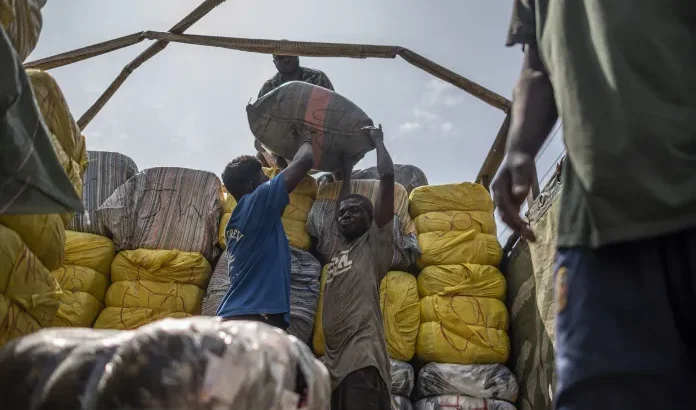As the country grapples with a severe environmental crisis due to the hazardous consequences of secondhand clothing waste, a levy has been proposed to better manage the situation.
Across every part of the country, once-vibrant landscapes and communities are now under siege as pollution from discarded garments takes a torturous toll on the nation.
Fast fashion, driven by the global demand for ever-changing trends, has inundated Ghana with a deluge of secondhand clothing.
Over 150,000,000kg of secondhand clothes are imported into the country on an annual basis, according to The Or Foundation. By its estimates, this is equivalent to around 15 million items every week.
“Our research – conducted over a period of six years and informed by immersive observation, hundreds of surveys, thousands of interviews, waste analysis and corresponding data from the municipality – has found that 40percent of the average bale of clothing opened in Accra’s Kantamanto second-hand clothing market, likely the largest secondhand clothing market in the world, leaves the market as waste,” portions of the organisation’s position paper read.
“This has created an environmental disaster in Ghana; a disaster that has unjustly become the burden of communities which did not cause the problem,” it adds.
Local environmentalists and concerned citizens have sounded the alarm, pointing to the detrimental effects of secondhand clothing waste on the nation’s air, water and soil.
Plant Manager at the Accra Compost and Recycling Plant (ACARP), Ganyo Kwabla Malik, calls for “a stricter regime” to monitor imports of secondhand clothing into the country.
“If possible, introduce some sort of levy to help players who will be interested in managing waste from this ecosystem. This will serve as a way of investing in the space,” he tells B&FT.
“As we have it now, the private individual who wants to invest in that space has to bear the cost of machinery and everything. But if there’s a levy of sorts in place, when the material comes in and reaches the end of its life, that money can be devoted to managing this type of waste by first retrieving it and then processing it into reusable materials. We believe that this is an area we can dialogue on to get some improvements into the space,” he states.
Clothing waste emerged as a significant factor contributing to the 2019 Kpone Landfill fire. The influx of fashion waste from various parts of the world, constituting approximately 20% of the landfill’s intended capacity, escalated the bulk density – impacting compaction rates and overwhelming Kpone Landfill’s engineered systems.
The inability of methane to escape due to these conditions resulted in a fire, ultimately leading to the landfill’s closure. This left one of the world’s fastest-growing metropolises without an engineered landfill.
Meanwhile, those involved in the secondhand clothing ecosystem are expressing concern over a staggering 153 percent surge in import duty; warning that without intervention thousands of Ghanaians could face loss of their livelihoods.
In the initial quarter of 2022, the Ghana Used Clothing Association (GAUCA) reported an import duty of GH¢15,000 for a 40-foot container. However, in first-quarter of the current year, this cost has skyrocketed to GH¢38,000.
GAUCA lamented that the situation has been exacerbated by factors such as cedi depreciation, high inflation and a challenging economic environment, which includes the deteriorating purchasing power of consumers and additional taxes.
“The situation is posing an existential threat to our livelihoods. This business used to be very lucrative, serving as a source of income for many Ghanaian young men and women who otherwise would have been at home doing nothing. But as I speak, we now operate on narrow profit margins due to the increasing bale-price and low customer patronage.
“Personally speaking, there are days when I come here and go back home after selling nothing,” Samuel Darko Apenteng, Secretary of the Used Clothing Dealers Association at Kantamanto in Accra told the B&FT in an earlier report.


